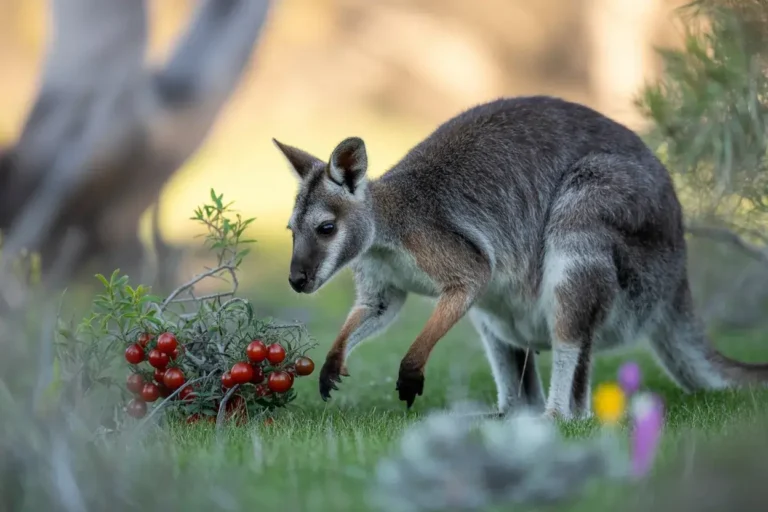Wallabies vs Kangaroos: What’s the Difference?
When it comes to iconic Australian wildlife, two animals often come to mind: wallabies and kangaroos. These two creatures belong to the same family, Macropodidae, but they are distinct in several important ways. Understanding their differences can enhance our knowledge of their biology, behaviour, and the environments they inhabit. In this article, we’ll explore the key differences between wallabies and kangaroos in terms of size, structure, and habitat.
Size Differences: Wallabies vs. Kangaroos
One of the most noticeable differences between wallabies and kangaroos is their size. While both animals are known for their powerful hind legs and strong tails, kangaroos tend to be much larger.
- Kangaroos: Kangaroos are typically much larger than wallabies, with some species like the Red Kangaroo (Macropus rufus) standing over 8 feet tall when on their hind legs. Adult male kangaroos can weigh between 90 to 200 pounds, depending on the species.
- Wallabies: Wallabies are smaller in size compared to kangaroos. The average wallaby stands around 2 to 3 feet tall and weighs between 10 to 30 pounds. Their compact size makes them better suited to navigating dense forest environments and rocky terrains.
This size difference is particularly noticeable in their physical appearance, with kangaroos having a more muscular and larger build, while wallabies have a more compact and agile structure.
Structural Differences: Build and Body Shape
Although both animals share the same family, their body structure differs in a few key areas. The main difference lies in the size and build of their legs and tail, which are adapted for different environments.
- Kangaroos: Kangaroos are built for long-distance travel across open plains and grasslands. They have long, powerful legs designed for efficient hopping, which allows them to cover large distances quickly. Their large tail acts as a counterbalance when they are hopping and provides stability.
- Wallabies: Wallabies, on the other hand, have shorter and stronger limbs, which allow them to navigate through forests, bushes, and rocky areas. Their smaller size and more compact frame are advantageous in these more rugged environments. Wallabies also have a tail that helps with balance, but it is not as large or as heavy as that of a kangaroo.
While kangaroos have longer legs and a more pronounced tail, wallabies are built for agility and strength in environments that require quick, precise movements.
Habitat: Where Do Wallabies and Kangaroos Live?
The habitats of wallabies and kangaroos also differ, with each animal adapting to different regions of Australia and its surrounding islands.
- Kangaroos: Kangaroos are typically found in the open plains, savannas, and grasslands of Australia. They thrive in areas with vast, flat terrain where they can easily travel long distances in search of food and water. Species like the Red Kangaroo are common in the central and western regions of Australia, where they can cover large areas with minimal obstacles.
- Wallabies: Wallabies are more commonly found in forests, rocky outcrops, and bushland. They prefer areas with dense vegetation and cover, which allows them to hide from predators and find shelter. Wallabies are typically more adaptable to a variety of environments, including rainforests and mountainous regions. For example, the Swamp Wallaby is often found in the wetland areas along the east coast of Australia, while the Rock Wallaby is commonly found in rocky, rugged areas.
Wallabies are generally more adaptable to varying habitats, while kangaroos are more specialized for open, arid regions with plenty of space to roam.
Behavioral Differences: Social Structure and Movement
- Kangaroos: Kangaroos are known for their large social groups, often called mobs. These groups can include several kangaroos and are usually led by a dominant male. Kangaroos travel together to find food and water, and their behavior is highly social. Their long-distance hopping helps them cover the vast distances of their habitat.
- Wallabies: Wallabies are typically more solitary than kangaroos, although some species form small groups, especially during the mating season. Wallabies are known for their more secretive behavior and are often found alone or in small family units. Their ability to navigate through dense vegetation allows them to stay relatively hidden from predators.
Key Differences at a Glance
| Feature | Kangaroos | Wallabies |
| Size | Larger, up to 8 feet tall | Smaller, up to 3 feet tall |
| Weight | 90 to 200 pounds | 10 to 30 pounds |
| Habitat | Open plains, grasslands | Forests, rocky outcrops, bushland |
| Legs and Tail | Longer, designed for hopping | Shorter, more compact, for agility |
| Behaviour | Social, live in large mobs | Solitary, small family groups |
Conclusion
While wallabies and kangaroos share many similarities, their differences in size, structure, habitat, and behaviour make them unique in their own right. Kangaroos are larger and more suited to open, flat landscapes, while wallabies are smaller and more agile, thriving in forests and rocky environments. Understanding these differences allows us to appreciate the diverse adaptations of these fascinating animals, which play vital roles in Australia’s ecosystem.
FAQs About Wallabies vs. Kangaroos
1. Can wallabies and kangaroos interbreed?
No, wallabies and kangaroos cannot interbreed. They belong to different genera within the same family, Macropodidae, and their reproductive systems are not compatible.
2. Which is faster: a wallaby or a kangaroo?
Kangaroos are faster than wallabies. They can reach speeds of up to 35 miles per hour, while wallabies generally hop at slower speeds, around 20 miles per hour.
3. Are wallabies or kangaroos more dangerous?
Kangaroos are generally considered more dangerous due to their larger size and strength. However, both animals can be defensive if threatened.
4. Do wallabies live in groups like kangaroos?
Wallabies are usually more solitary than kangaroos, but some species do form small groups, particularly during the mating season.


